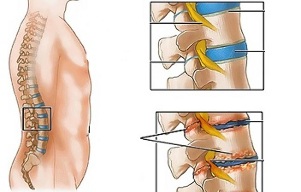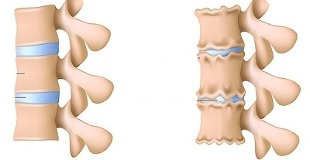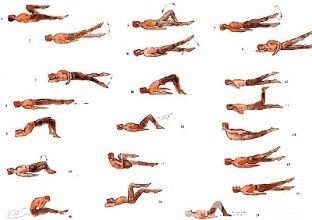
Lumbar osteochondrosis is a chronic disease that develops as a result of a degenerative-dystrophic process in the intervertebral discs. The disease is widespread and affects most people between 25 and 40 years of age.
According to statistics, one in two adults experience back pain at least once in their life, while in 95% of cases it is caused by osteochondrosis of the spine.
Patients with severe lumbar osteochondrosis, with persistent pain and other manifestations are recognized as temporarily disabled. If their conditions do not improve within four months, the question of setting up a disability group is decided.
Lumbar osteochondrosis is a serious medical and social problem, as the disease mainly affects people of working age and also, in the absence of treatment, can cause the formation of a herniated disc.
Causes and risk factors
The factors that predispose to the development of lumbar osteochondrosis are:
- abnormalities of the structure of the spinal column;
- lumbarization - congenital pathology of the spine, characterized by the separation of the first vertebra from the sacrum and its transformation into the sixth (additional) lumbar;
- sacralization is a congenital pathology in which the fifth lumbar vertebra is fused with the sacrum;
- asymmetrical arrangement of the joint spaces of the intervertebral joints;
- pathological narrowing of the spinal canal;
- reflected spondiogenic pain (somatic and muscular);
- obesity;
- sedentary lifestyle;
- prolonged exposure to vibrations;
- systematic physical stress;
- smoking.
Unfavorable static-dynamic loads in combination with one or more risk factors lead to a change in the physiological properties of the nucleus pulposus of the fibrous disc, which plays a shock-absorbing role and provides mobility to the spine. This process is based on the depolymerization of polysaccharides, which leads to the loss of moisture in the tissue of the gelatinous core. As a result, the nucleus pulposus, and with it the fibrous disc, lose their elastic properties. Further mechanical stresses cause the fibrous ring to protrude which has lost its elasticity. This phenomenon is called protrusion. In the fibrous core, cracks appear, through which fragments of the nucleus pulposus fall (prolapse, herniated disc).
Prolonged compression of the nerve roots that innervate some organs of the abdominal cavity over time leads to a deterioration of their functioning.
Instability of the spinal segment is accompanied by reactive changes in the bodies of the adjacent vertebrae, intervertebral joints, and concomitant spondylarthrosis develops. A significant muscle contraction, for example, against the background of physical activity, leads to a displacement of the vertebral bodies and the entrapment of nerve roots with the development of radicular syndrome.
Another cause of pain and neurological symptoms in lumbar osteochondrosis can be osteophytes, bone growths on vertebral processes and bodies that cause radicular syndrome or compression myelopathy (compression of the spinal cord).
Forms of the disease
Depending on the structures involved in the pathological process, lumbar osteochondrosis manifests itself clinically with the following syndromes:
- reflex- lumbodynia, lumboishalgia, low back pain; develop against the background of a reflex overload of the back muscles;
- compression (spinal, vascular, radicular)- compression (compression) of the spinal cord, blood vessels or nerve roots leads to their development. Examples are lumbosacral radiculitis, radiculoischemia.
Symptoms of lumbar osteochondrosis
In lumbar osteochondrosis, the symptoms are determined by the structures involved in the pathological process.
Low back pain occurs under the influence of hypothermia or physical overload and sometimes for no apparent reason. The pain appears suddenly and is of a shooting character. It intensifies when sneezing, coughing, turning the body, exercising, sitting, standing, walking. In the supine position, pain sensations are noticeably weakened. Sensitivity and reflexes are preserved, the range of motion in the lumbar spine is reduced.
Observe on palpation:
- pain in the lumbar region;
- spasm of the paravertebral muscles;
- flattening of the lumbar lordosis, which in many cases is associated with scoliosis.
Nerve root tension syndrome in low back pain is negative. When lifting a straight leg, patients notice an increase in pain in the lumbar region and not their appearance in an extended lower limb.
Often, with lumbar osteochondrosis, relapses of pain attacks occur, which each time become more intense and prolonged.
In lumbodynia, the clinical picture is similar to low back pain, but the increase in pain intensity occurs over several days.
In lumboishalgia, patients complain of pain in the lumbar region, which radiates to one or both lower limbs. The pain spreads to the buttocks and back of the thigh and never reaches the feet.
Vasomotor disorders are characteristic of lumboishalgia:
- changes in temperature and color of the skin of the lower limbs;
- feeling hot or cold;
- violation of blood circulation.
The development of lumbar compression syndromes is clinically manifested by the following symptoms:
- dermatomal hypalgesia;
- shooting pains;
- weakening or complete loss of deep reflexes;
- peripheral paresis.
In compression syndromes, pain is aggravated by trunk flexion, sneezing, and coughing.
Diagnostics
Diagnosis of lumbar osteochondrosis is made on the basis of the data of the clinical picture of the disease, laboratory and instrumental research methods.
In blood tests on the background of lumbar osteochondrosis:
- decrease in calcium concentration;
- increased ESR;
- increased alkaline phosphatase levels.
X-ray examination of the spine is of great importance in the diagnosis of lumbar osteochondrosis.
Prolonged compression of the nerve roots that innervate some organs of the abdominal cavity over time leads to a deterioration of their functioning.
The X-ray signs confirming the diagnosis are:
- modifies the configuration of the segment concerned;
- pseudospondylolisthesis (displacement of adjacent vertebral bodies);
- deformation of the closing plates;
- flattening of the intervertebral disc;
- unequal height of the intervertebral disc (a symptom of a spacer), which is associated with asymmetrical muscle tone.

Also in the diagnosis of lumbar osteochondrosis, if indicated, the following are used:
- myelography, magnetic resonance or computed imaging - are necessary for persistent symptoms, the development of neurological deficits;
- scintigraphy (study of the accumulation of phosphorus in the bone system, labeled with tech-99) - is performed if there is a suspicion of a tumor or an infectious process, spinal injury.
Differential diagnosis of lumbar osteochondrosis is performed with the following diseases:
- spondylolisthesis;
- dyshormonal spondylopathy;
- ankylosing spondylitis (ankylosing spondylitis);
- infectious processes (inflammation of the disc, spinal osteomyelitis);
- neoplastic processes (primary tumor of the spine or its metastatic lesions);
- rheumatoid arthritis;
- deforming osteoarthritis of the hip joint;
- reflected pain (diseases of internal organs and large blood vessels).
Treatment of lumbar osteochondrosis
For lumbar osteochondrosis, the following treatment tactics are usually followed:
- bed rest for 2-3 days;
- traction of the affected segment of the spine;
- strengthen the muscles of the back and abdominal muscles (creating the so-called muscle corset);
- impact on pathological and myotonic myofascial processes.
Low back pain occurs under the influence of hypothermia or physical overload and sometimes for no apparent reason.
In most cases, conservative treatment of lumbar osteochondrosis is performed, including the following:
- muscle infiltration anesthesia with a solution of local anesthetics;
- taking non-steroidal anti-inflammatory drugs;
- taking desensitizing agents;
- vitamin therapy;
- taking tranquilizers and antidepressants;
- manual therapy, massage;
- physiotherapy exercises;
- acupuncture;
- post-isometric relaxation.
The absolute indications for the surgical treatment of lumbar osteochondrosis are:
- acute or subacute spinal cord compression;
- development of cauda equina syndrome, characterized by dysfunction of the pelvic organs, sensory and movement disorders.
Corrective gymnastics for lumbar osteochondrosis

Physiotherapy plays a significant role in the complex treatment of lumbar osteochondrosis. Regular exercises allow you to normalize the muscle tone of the paravertebral muscles, improve metabolic processes in the tissues affected by the pathological process, and additionally form a well-developed muscular corset that can support the spine in the correct position, relieve unnecessary static loads from it.
In order for gymnastics with lumbar osteochondrosis to bring the maximum effect, it is necessary to adhere to the following principles:
- regularity of classes;
- gradual increase in the intensity of physical activity;
- avoid overwork during the lesson.
Physiotherapy should be performed under the guidance of an experienced instructor, who will select the most effective exercises for a particular patient and check the correctness of their implementation.
According to statistics, one in two adults experience back pain at least once in their life, while in 95% of cases it is caused by osteochondrosis of the spine.
In addition to classes with an instructor, you should perform a series of morning exercises daily, which include special exercises for lumbar osteochondrosis.
- Relaxation and contraction of the abdominal muscles.The starting position is standing, feet shoulder-width apart, arms lowered to the body. Take a gentle breath, relaxing the muscles of the anterior abdominal wall. As you exhale, pull the abdomen as much as possible, straining the abdominal muscles. Exercise should be repeated until mild fatigue appears.
- Head movements with spinal flexion.The starting position is kneeling, resting on the ground with outstretched arms, back straight. Slowly raise your head and lean into your back. Hold this position for a few seconds, then smoothly return to the starting position. Repeat at least 10-12 times.
- "Pendulum".Starting position lying on the back, arms along the body, legs bent at right angles at the knee and hip joints. Rotate your legs left and right in pendulum-like swinging motions, trying to reach the floor. In this case, the shoulder blades cannot be torn off the floor.
- Boat.Starting position lying on the stomach, arms stretched forward. Rip your upper body and legs off the floor, bending in the back. Hold this position for 5-6 seconds and slowly return to the starting position. Run 10 times.
Potential consequences and complications
The main complications of lumbar osteochondrosis are:
- formation of an intervertebral hernia;
- vegetative-vascular dystonia;
- spondylolysis, spondylolisthesis;
- osteophytosis;
- spondyloarthrosis;
- stenosis of the spinal canal, which leads to compression of the spinal cord and can cause permanent disability and decreased quality of life.
Prolonged compression of the nerve roots that innervate some organs of the abdominal cavity over time leads to a deterioration of their functioning. As a result, patients have intestinal dysfunction (constipation, diarrhea, flatulence) and pelvic organs (urinary disorders, erectile dysfunction, frigidity, infertility).
Forecast
Pain syndrome in lumbar osteochondrosis manifests itself in the form of remissions and exacerbations. Low back pain lasts 10-15 days, after which the patient's condition improves, the pain subsides. A favorable outcome can be prevented from associated secondary diseases. Often, with lumbar osteochondrosis, there is a recurrence of pain attacks, which each time become more intense and prolonged.
Physiotherapy plays a significant role in the complex treatment of lumbar osteochondrosis.
Patients with severe lumbar osteochondrosis, with persistent pain and other manifestations are recognized as temporarily disabled. If their conditions do not improve within four months, the question of setting up a disability group is decided.
Prevention
Prevention of the development of osteochondrosis of the spine consists of the following measures:
- stop smoking;
- normalization of body weight;
- improvement of general physical condition, active lifestyle;
- avoid provocative conditions (weight lifting, sudden movements, turns, bends).













































